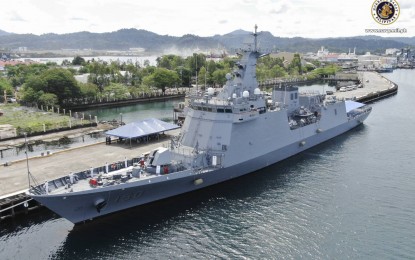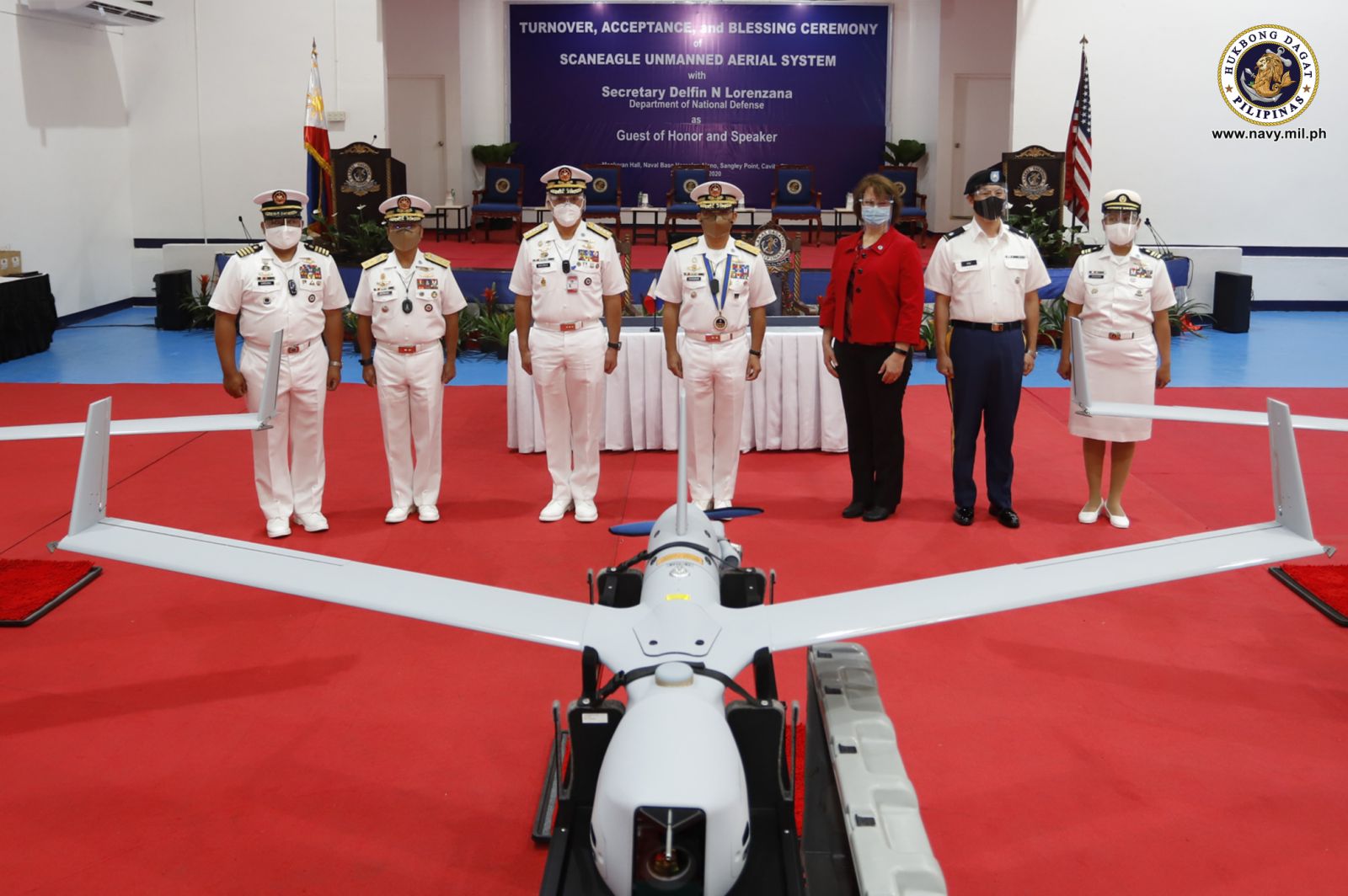
UPGRADES ON TRACK. BRP Jose Rizal, the Philippines' first-missile frigate is docked at Subic Bay, Zambales. Philippine Navy chief Vice Adm. Giovanni Carlo Bacordo said efforts to upgrade the Navy remain intact despite the ongoing coronavirus disease 2019 (Covid-19) pandemic. (File photo courtesy of Naval Public Affairs Office)
MANILA – Despite the coronavirus disease 2019 (Covid-19) pandemic bringing almost everything to a standstill this year, efforts to modernize the Philippine Navy (PN) remain on track as exemplified by the delivery and commissioning of its first-ever guided-missile frigate BRP Jose Rizal (FF-150) early this year.
"Despite the Covid-19 pandemic greatly affecting the implementation of the AFP’s Modernization Program this year, the PN has remained in high spirits in terms of developing its capabilities. For one, the Navy has seen the arrival of its first modern frigate, BRP Jose Rizal in May of this year," Navy chief Vice Adm. Giovanni Carlo Bacordo told the Philippine News Agency (PNA) in a recent interview.
The ship arrived in Subic Bay, Zambales last May 23 after leaving Hyundai Heavy Industries (HHI) shipyard in Ulsan, South Korea last May 18.
The BRP Jose Rizal is capable of conducting anti-air warfare, anti-surface warfare, anti-submarine warfare, and electronic warfare operations and was officially commissioned last July 10.
A few weeks after its commissioning, the ship and its crew were deployed to the biennial "Rim of the Pacific" (RIMPAC) exercises off Hawaii which took place from Aug. 17 to 31.
The ship left Subic Bay on July 29 and arrived in Hawaii on Aug. 15.
Bacordo said this deployment is considered the "maiden deployment" of the brand-new missile frigate and called the participation of the ship and its contingent to the RIMPAC as a "sterling one".
Also, no defects were reported aboard BRP Jose Rizal during the two-week maneuvers.
"No reported safety and security incidents. No weapons, communications, electronic(s) and information (system) hull, machinery, and electrical sys(tem) derangements (were) reported," Bacordo earlier said.
He added that BRP Jose Rizal’s participation in RIMPAC 2020 highlights the competence and capability of the ship and its crew to undertake various maritime operational scenarios, may it be multinational operations with other partner nations, maritime security of commercial shipping, or operating on its own or with its onboard helicopter against surface and sub-surface adversaries.
"FF-150 took advantage of RIMPAC 2020 to train as a team, put the ship at pace with possible real-world scenarios, and the crew to gel during this time," he said.
Bacordo said the ship's participation was also recognized by its US counterparts, specifically US Navy Third Fleet commander Vice Admiral Scott D. Conn, who earlier said they are happy to have the Philippines participating in RIMPAC with BRP Jose Rizal.
PN public affairs office chief Lt. Commander Maria Christina Roxas said the ship's crew would use the two-week RIMPAC maneuvers as a "shakedown cruise" to test the performance and seaworthiness of the brand-new missile frigate.
A "shakedown cruise" allows the crew to familiarize themselves with a new vessel and ensure that all of the ship's systems are functional.
"Other than that, it is a chance for the officers and crew to work as a team since most of the time they are conducting individual training. Through this exercise, they will be able to conduct and function as a whole team of FF-150," she said.
The RIMPAC, being a multi-dimensional training exercise, gave a chance for the BRP Jose Rizal "to level up its engagement in this four-dimension warfare," Roxas added.
BRP Jose Rizal was launched at the Hyundai Heavy Industries (HHI) shipyard in Ulsan, South Korea on May 23, 2019. Its sister ship, the BRP Antonio Luna (FF-151), was launched in the same facility on November 8 last year.
The contract for the two ships was PHP16 billion and an additional PHP2 billion for weapon systems and munitions.
Aside from the arrival and commissioning of the PN's first guided-missile frigate, another highlight for the Navy this year is the partial delivery of the 10 high-speed and fast boats contracted for the Naval Special Operations Command (Navsocom).
"In addition, in August of this year, the Navsocom also saw the partial delivery of seven out of 10 high-speed and fast boats acquired under the modernization program and meant to boost special operations capability. These are currently undergoing sea trial and technical inspection procedures," Bacordo said.
ScanEagle drones
Also of great importance for the PN was the acquisition of the ScanEagle unmanned aerial system with the assistance of the United States,
"Further, the PN has received through (Foreign Military Sales) FMS the donation of ScanEagle unmanned aerial system (UAS), composing of eight air vehicles, four ground-control stations, and other components that can greatly contribute to the ISR (intelligence, surveillance, and reconnaissance) operations and RDANA (rapid damage assessment), (support to humanitarian assistance disaster relief (HADR)," Bacordo said.

Also included in this package are training for the operators and maintainers (10 pilot and six maintainers, four image and video data processors) to ensure optimized utilization," he added.
During the formal turnover of the ScanEagle UAS last Nov. 25 at Naval Base Heracleo Alano, Sangley Point, Cavite, Bacordo said the arrival of this platform will allow the PN to greatly expand the coverage of its internal security, territorial defense, HADR, and maritime law enforcement missions.
This is the first fixed UAS to be operated by the PN. The ScanEagle and its associated equipment, worth USD14.79 million, were acquired through the Maritime Security Initiative Program of the United States.
It was requested by the PN in 2017 and was formalized in February 2019 after a series of dialogues with the Philippines’ Joint US Military Assistance Group (JUSMAG-Phil).
"Another milestone was achieved just recently which includes the successful negotiations for the Lot 1 (Platforms) & Lot 2 (Combat Systems and Missiles) of the Fast Attack Interdiction Craft-Missile (FAIC-M) Acquisition Project. This resulted in the provisions for an additional one unit with one set of remote combat weapon systems (on top of the programmed eight units FAIC-M) for the PN and an upgrade of the Naval Ship Yard -- without additional cost to the government. Hence, the PN expects to obtain a total of nine missile-equipped FAICs in the coming years," Bacordo said.
The FAIC-Ms, Bacordo said, are expected to replace the force of patrol killer medium (PKM) or medium-sized patrol craft, with deliveries expected to start in 2022.
The project, approved for inclusion in the Horizon 2 project list of the Revised Armed Forces of the Philippines Modernization Program, has a budget of PHP10 billion and is for multi-year contracting.
Four of the FAIC-Ms will be armed with non-line-of-sight (NLOS) missiles with pinpoint accuracy and a range of 25 kilometers while the other four will be armed with machine guns and light automatic cannons.
With the FAIC-Ms, the PN shall have the capability to defend the key sea lines of communications (SLOCs), such as Mindoro, Balabac, Sibutu, and Basilan Straits against conventional threats.
While operating in restricted waters, the FAIC-Ms can interdict surface threats and launch NLOS missiles safely using the surrounding littoral areas as maneuver space and cover.
2nd missile frigate soon
Another important event for the PN in 2020 is the successful conclusion of the five-day sea acceptance trials (SAT) of BRP Antonio Luna, the second missile frigate ordered by the Navy from HHI.
The SAT started on Dec. 14 and ended on Dec. 18.

"As the second installment of the Frigate Acquisition Project, the FF-151 or BRP Antonio Luna concluded its five-day Sea Acceptance Trials recently on 18 December 2020 in South Korea. As a result, the PN is expecting to welcome this modern vessel in February 2021 and project delivery remains to be right on schedule," Bacordo said.
In a media statement on Dec. 18, Rear Admiral Alberto Carlos, head of the PN's Technical Inspection and Acceptance Committee (TIAC), declared that FF-151 is compliant with the agreed technical specifications after personally witnessing the warship's performance during the sea trials.
"FF-151 is 95 percent complete at this time. All machinery and combat systems were subjected to test procedures as stipulated in the contract and were observed to be working properly. More importantly, I'm happy to announce that FF-151 passed the prescribed standards and procedures," he said.
Carlos said upon completion of the SAT, BRP Antonio Luna's completion rating is almost 100 percent. This, he added, will pave way for the frigate re-docking and final outfitting before delivery early next year.
Also, Bacordo said parallel with equipment acquisition is the command’s effort on base support and sustainment development that would address the facility requirements for the upcoming deliverables of the PN modernization program like the missile storage facilities and repair of piers and other major infrastructure, among others.
"Moreover, the non-material aspects that are crucial to the overall effort of the PN modernization are considered through the Capability Synchronization Matrix. As a crucial management tool, the matrix is seen to identify, program, integrate, implement, and monitor the overall capability development of the PN," he added.
This also includes alignment of materiel and non-materiel capabilities covering training activities that would enhance personnel competency for our personnel, doctrines development, force restructuring and organizational development, and human resource development.
Also, the PN chief is pleased to announce that the Navy is continuing its efforts in supporting the local defense industry research and development under the Self-Reliant Defense Posture program.
"In 2020, in collaboration with the Department of Science and Technology, we have seen the active implementation and near completion of 'Project Buhawi' or (building a universal mount for heavy-barrel automated weapon integration for naval vessels)," Bacordo said. (PNA)
